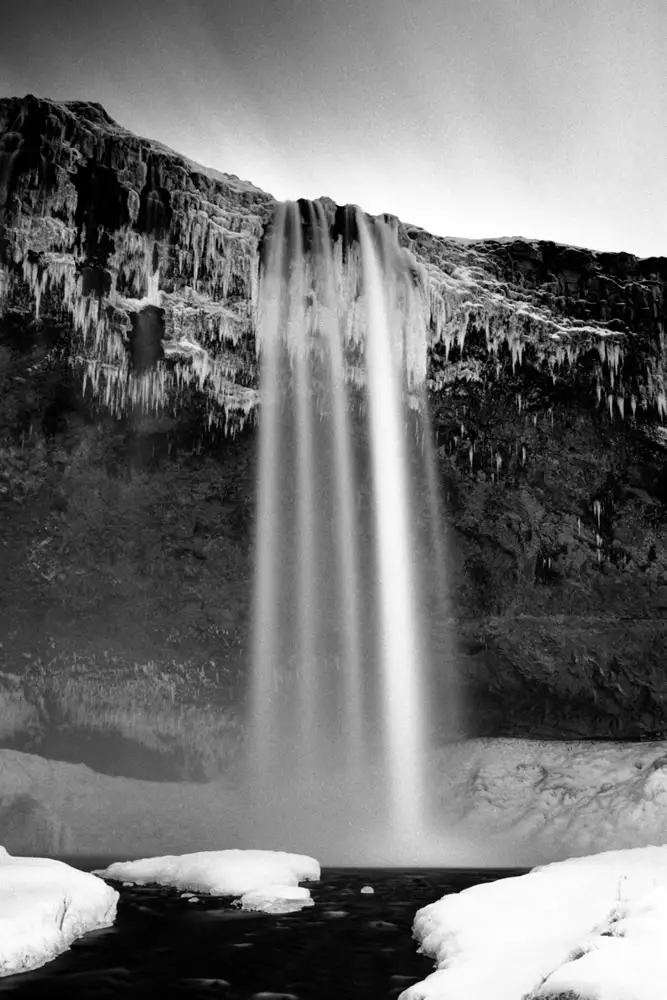Iceland. Winter.
You’re standing at the base of a waterfall, semi-numb fingers fumbling a new roll of 35mm into the back of your ice-cold SLR. Before you – yards away – the fall thunders down past chandeliers of icicles into a churning basin of coal-black water, snow and slush.
Around you are ice-bleached bleak mountains, impassively watching you freeze beneath iron-grey skies and amid vicious flurries of needle-sharp snow.

Perfect, you think, for a spot of slow-exposure photography. You set your exposure – 1/8″ at f8. You slap on a ten-stop ND filter and wipe away a stray snowflake. A glance at your aide memoire tells you to set your shutter to 2 minutes. You fit your manual shutter release, set the timer and…
…well, here you should pause.

Your ND filter chart is accurate up to a point. The law of reciprocity is simple enough: reduce the light reaching the film by 10 stops and you need to make a reciprocal compensation in your exposure time: 1/8″ plus 10 stops is 2 minutes. But it’s not so simple with film.
The law of reciprocity holds for shutter speeds up to a particular point, but a quirk of chemistry means film doesn’t respond uniformly to changes in exposure time longer than about 1/2″ (with some exceptions). Beyond that point, halving the light intensity means you need to more than double the exposure time. Wikipedia explains the science quite succinctly. (Helpfully, if you don’t want to fiddle with graphs and rules-of-thumb, there are great apps for iPhone and Android devices that can help you.)

For some, reciprocity failure means wasted time. For me, it’s another joy of film photography. I adopted film to force me to slow down while working on the streets – to take time to concentrate on catching the decisive moment instead of salami-slicing stretches of time with burst mode.
And so it goes for landscapes: no trashy tourist shot is worth wasting part of my precious film, so I try to evaluate the scene, composition and other factors all the more carefully. Reciprocity failure gives me downtime to think about the next shot, or enjoy the elements around me. Whether the results are worth the effort… Well, that’s for you to decide.

Back to Iceland.
You’re using Kodak T-Max 100 (beautiful): 2 minutes on the meter is worth 4min 30sec on the clock. Pour yourself some coffee; set the timer; open the shutter; wait; close it. Bracket. Wind on. Repeat. All the more time to enjoy the sweet solitude, the roaring cascade and the joy of a job well done.


PS… If you are tempted to try some extra-long exposures, keep some electrical tape handy to cover your viewfinder. Light leaks might suit the Lomo aesthetic, but if you’re after clean prints they’re a pain.
~ Andy Wasley
Share your knowledge, story or project
The transfer of knowledge across the film photography community is the heart of EMULSIVE. You can add your support by contributing your thoughts, work, experiences and ideas to inspire the hundreds of thousands of people who read these pages each month. Check out the submission guide here.
If you like what you’re reading you can also help this passion project by heading over to the EMULSIVE Patreon page and contributing as little as a dollar a month. There’s also print and apparel over at Society 6, currently showcasing over two dozen t-shirt designs and over a dozen unique photographs available for purchase.








5 responses to “Reciprocity failure in landscape long exposures”
Thanks, great shots
4.5
i
Beeeeeeyooooootiful stuff!
Thank you ☺️